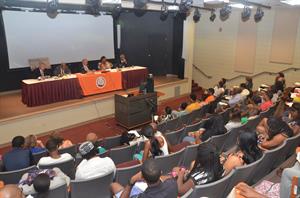50 Years Later: Symposium Looks at Before, During and After Desegregation in South Carolina
Nov 04, 2013
 Fifty years ago this week, Claflin University history professor Dr. Millicent Brown was one of 11 African-American students who helped desegregate Charleston County schools, becoming one of the first two black students at Rivers High School.
Fifty years ago this week, Claflin University history professor Dr. Millicent Brown was one of 11 African-American students who helped desegregate Charleston County schools, becoming one of the first two black students at Rivers High School.
Today, she and other “first children” were joined by professors and historians familiar with state and national desegregation efforts at the daylong symposium “From Brown (1954) to Brown (1963) and Beyond: Achieving Educational Equity in South Carolina,” held in the Grace Thomas Kennedy Building Auditorium at Claflin University.
Brown was the chief plaintiff in Millicent E. Brown et al. vs. Charleston County School Board District 20 in 1963, which led to the desegregation of all public schools in South Carolina. She said the symposium was just one of the events being held as part of the academic and cultural “Jubilee Project,” which celebrates the 150th anniversary of the Emancipation Proclamation and the 50th anniversary of the desegregation of the state’s public education, and commemorates other key events both of 1863 and of the civil rights movement in 1963.
“It is important that we look at the history of what happened, starting as far back as 150 years ago” with the signing of the Emancipation Proclamation, Brown said. “We see that as a pivotal time in American history – and certainly in African-American history – where hopes of freedom from enslavement brought ideas of being recognized as actual people. But the struggle continued so that we now start talking about 1963 and the movements for first-class citizenship.”
The purpose of the symposium, she said, was to address the role the state, counties and communities play in providing quality education for all students.
Discussions began with an exploration of the legal and political history of statewide desegregation in “What We Wanted.”
Panelist Minerva King, media specialist at St. John’s High School on Johns Island and professional storyteller and the original plaintiff in the Brown v. Charleston County School District 20 case, said the fight for desegregation wasn’t about being able to sit next to white students in a classroom.
“I think primarily what we wanted was some relief from a terribly overcrowded and unequal school situation in Charleston County,” she said. “We were literally bursting at the seams of the school.”
When she graduated from Charleston’s Burke High School in 1961, King said there were roughly 1,900 students at the school – and some 800 in her graduating class alone. The schools she attended were so overcrowded that two or three different sessions were held daily to accommodate all of the students.
“Not only was it extremely overcrowded,” she said. “The buildings were rather old. When it rained, we often got wet. We also got second-hand books, second-hand furniture.
“School desegregation was not all about feeling the need to go to school with white children. It was all about getting some equality in schools, trying to get some relief for these substandard schools. … We were about getting better facilities.”
While the facilities may have been substandard, King said, the teachers at her schools were not.
“Many of these teachers came over from Avery,” King said, referring to the Avery Normal Institute, one of Charleston’s first black schools and its longest-surviving educational institution from the Reconstruction period that offered what King called a “holistic” and “classical” education where students learned everything from carpentry to Latin.
“They carried with them this classical education,” she said of Charleston’s black teachers. “In many, many cases, they were a lot better prepared than their white counterparts in Charleston.”
The remaining sessions featured narratives from desegregation pioneers throughout South Carolina in “What We Got”; discussed post-desegregation educational responses, policies and programs in “What We Tried”; and examined the continuing challenges to equity in education and innovative approaches for the present and future in “What Is Possible.” Comments and questions were entertained following each panel session.
The event was held in partnership with the College of Charleston's Center for Partnerships for Improvements in Education and the South Carolina Humanities Council. It was also supported by Brown’s research project at Claflin entitled “Somebody Had to Do It,” which gathers stories of the first black children to integrate public school systems.
The symposium was streamed live to off-site locations including Savannah State College in Savannah, Ga., the College of Charleston, South Carolina State University, Voorhees College in Denmark, the University of South Carolina in Columbia, Clemson University and Ridge View High School in Columbia. Greenville-based WMXP 95.5 FM also audio streamed the event.
Attendees were given a program that included a list of resources about desegregation, a timeline of desegregation in South Carolina, and biographies for symposium moderators and panelists. Copies of the program will be available at Claflin University’s Department of History and Sociology and on the “Somebody Had to Do It” Project website at http://somebody.claflin.edu.